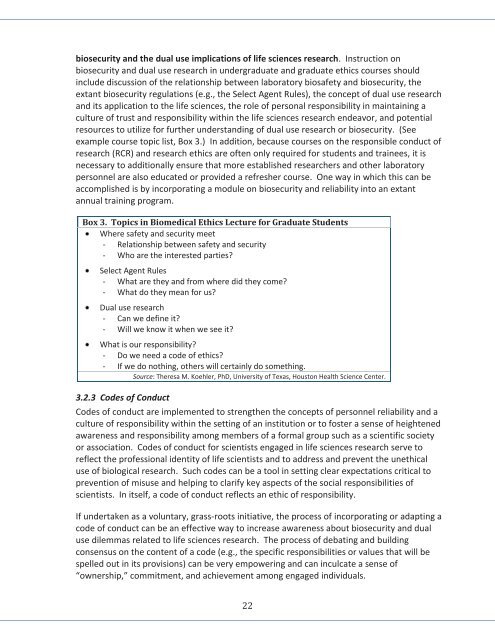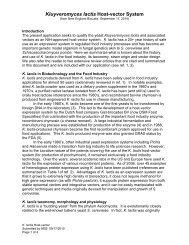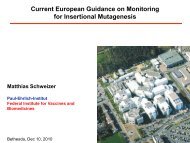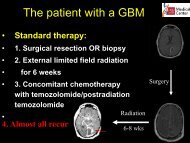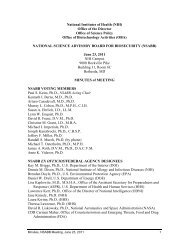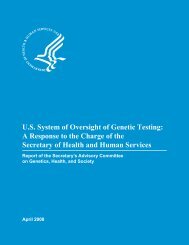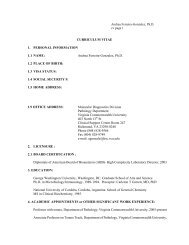Guidance for Enhancing Personnel Reliability and Strengthening ...
Guidance for Enhancing Personnel Reliability and Strengthening ...
Guidance for Enhancing Personnel Reliability and Strengthening ...
You also want an ePaper? Increase the reach of your titles
YUMPU automatically turns print PDFs into web optimized ePapers that Google loves.
iosecurity <strong>and</strong> the dual use implications of life sciences research. Instruction on<br />
biosecurity <strong>and</strong> dual use research in undergraduate <strong>and</strong> graduate ethics courses should<br />
include discussion of the relationship between laboratory biosafety <strong>and</strong> biosecurity, the<br />
extant biosecurity regulations (e.g., the Select Agent Rules), the concept of dual use research<br />
<strong>and</strong> its application to the life sciences, the role of personal responsibility in maintaining a<br />
culture of trust <strong>and</strong> responsibility within the life sciences research endeavor, <strong>and</strong> potential<br />
resources to utilize <strong>for</strong> further underst<strong>and</strong>ing of dual use research or biosecurity. (See<br />
example course topic list, Box 3.) In addition, because courses on the responsible conduct of<br />
research (RCR) <strong>and</strong> research ethics are often only required <strong>for</strong> students <strong>and</strong> trainees, it is<br />
necessary to additionally ensure that more established researchers <strong>and</strong> other laboratory<br />
personnel are also educated or provided a refresher course. One way in which this can be<br />
accomplished is by incorporating a module on biosecurity <strong>and</strong> reliability into an extant<br />
annual training program.<br />
Box 3. Topics in Biomedical Ethics Lecture <strong>for</strong> Graduate Students<br />
Where safety <strong>and</strong> security meet<br />
- Relationship between safety <strong>and</strong> security<br />
- Who are the interested parties?<br />
Select Agent Rules<br />
- What are they <strong>and</strong> from where did they come?<br />
- What do they mean <strong>for</strong> us?<br />
Dual use research<br />
- Can we define it?<br />
- Will we know it when we see it?<br />
What is our responsibility?<br />
- Do we need a code of ethics?<br />
- If we do nothing, others will certainly do something.<br />
Source: Theresa M. Koehler, PhD, University of Texas, Houston Health Science Center.<br />
3.2.3 Codes of Conduct<br />
Codes of conduct are implemented to strengthen the concepts of personnel reliability <strong>and</strong> a<br />
culture of responsibility within the setting of an institution or to foster a sense of heightened<br />
awareness <strong>and</strong> responsibility among members of a <strong>for</strong>mal group such as a scientific society<br />
or association. Codes of conduct <strong>for</strong> scientists engaged in life sciences research serve to<br />
reflect the professional identity of life scientists <strong>and</strong> to address <strong>and</strong> prevent the unethical<br />
use of biological research. Such codes can be a tool in setting clear expectations critical to<br />
prevention of misuse <strong>and</strong> helping to clarify key aspects of the social responsibilities of<br />
scientists. In itself, a code of conduct reflects an ethic of responsibility.<br />
If undertaken as a voluntary, grass-roots initiative, the process of incorporating or adapting a<br />
code of conduct can be an effective way to increase awareness about biosecurity <strong>and</strong> dual<br />
use dilemmas related to life sciences research. The process of debating <strong>and</strong> building<br />
consensus on the content of a code (e.g., the specific responsibilities or values that will be<br />
spelled out in its provisions) can be very empowering <strong>and</strong> can inculcate a sense of<br />
“ownership,” commitment, <strong>and</strong> achievement among engaged individuals.<br />
22


